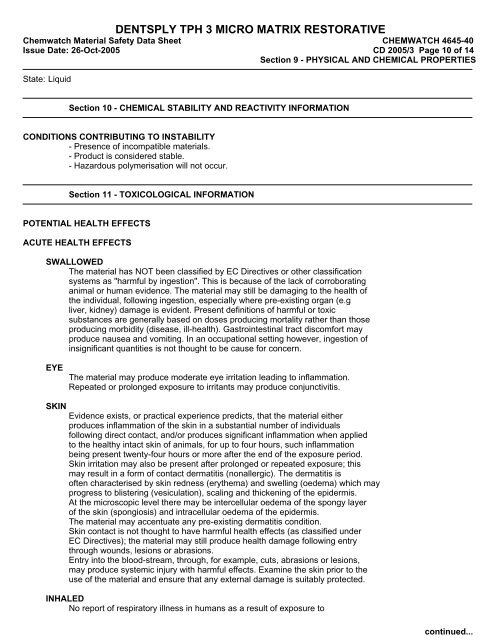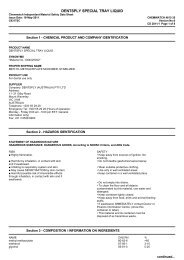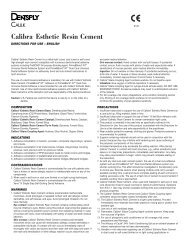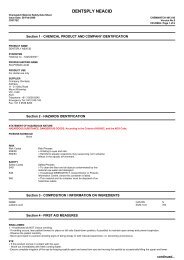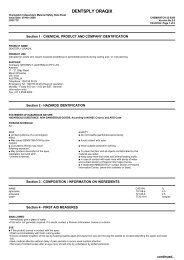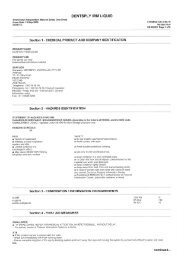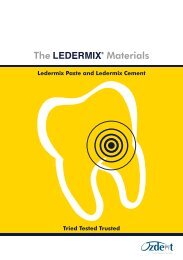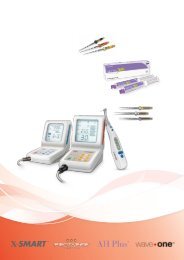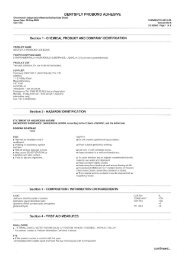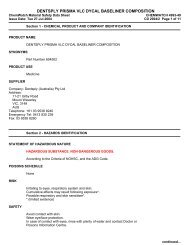dentsply tph 3 micro matrix restorative
dentsply tph 3 micro matrix restorative
dentsply tph 3 micro matrix restorative
You also want an ePaper? Increase the reach of your titles
YUMPU automatically turns print PDFs into web optimized ePapers that Google loves.
DENTSPLY TPH 3 MICRO MATRIX RESTORATIVE<br />
Chemwatch Material Safety Data Sheet CHEMWATCH 4645-40<br />
Issue Date: 26-Oct-2005 CD 2005/3 Page 10 of 14<br />
Section 9 - PHYSICAL AND CHEMICAL PROPERTIES<br />
State: Liquid<br />
Section 10 - CHEMICAL STABILITY AND REACTIVITY INFORMATION<br />
CONDITIONS CONTRIBUTING TO INSTABILITY<br />
- Presence of incompatible materials.<br />
- Product is considered stable.<br />
- Hazardous polymerisation will not occur.<br />
Section 11 - TOXICOLOGICAL INFORMATION<br />
POTENTIAL HEALTH EFFECTS<br />
ACUTE HEALTH EFFECTS<br />
SWALLOWED<br />
The material has NOT been classified by EC Directives or other classification<br />
systems as "harmful by ingestion". This is because of the lack of corroborating<br />
animal or human evidence. The material may still be damaging to the health of<br />
the individual, following ingestion, especially where pre-existing organ (e.g<br />
liver, kidney) damage is evident. Present definitions of harmful or toxic<br />
substances are generally based on doses producing mortality rather than those<br />
producing morbidity (disease, ill-health). Gastrointestinal tract discomfort may<br />
produce nausea and vomiting. In an occupational setting however, ingestion of<br />
insignificant quantities is not thought to be cause for concern.<br />
EYE<br />
The material may produce moderate eye irritation leading to inflammation.<br />
Repeated or prolonged exposure to irritants may produce conjunctivitis.<br />
SKIN<br />
Evidence exists, or practical experience predicts, that the material either<br />
produces inflammation of the skin in a substantial number of individuals<br />
following direct contact, and/or produces significant inflammation when applied<br />
to the healthy intact skin of animals, for up to four hours, such inflammation<br />
being present twenty-four hours or more after the end of the exposure period.<br />
Skin irritation may also be present after prolonged or repeated exposure; this<br />
may result in a form of contact dermatitis (nonallergic). The dermatitis is<br />
often characterised by skin redness (erythema) and swelling (oedema) which may<br />
progress to blistering (vesiculation), scaling and thickening of the epidermis.<br />
At the <strong>micro</strong>scopic level there may be intercellular oedema of the spongy layer<br />
of the skin (spongiosis) and intracellular oedema of the epidermis.<br />
The material may accentuate any pre-existing dermatitis condition.<br />
Skin contact is not thought to have harmful health effects (as classified under<br />
EC Directives); the material may still produce health damage following entry<br />
through wounds, lesions or abrasions.<br />
Entry into the blood-stream, through, for example, cuts, abrasions or lesions,<br />
may produce systemic injury with harmful effects. Examine the skin prior to the<br />
use of the material and ensure that any external damage is suitably protected.<br />
INHALED<br />
No report of respiratory illness in humans as a result of exposure to<br />
continued...


